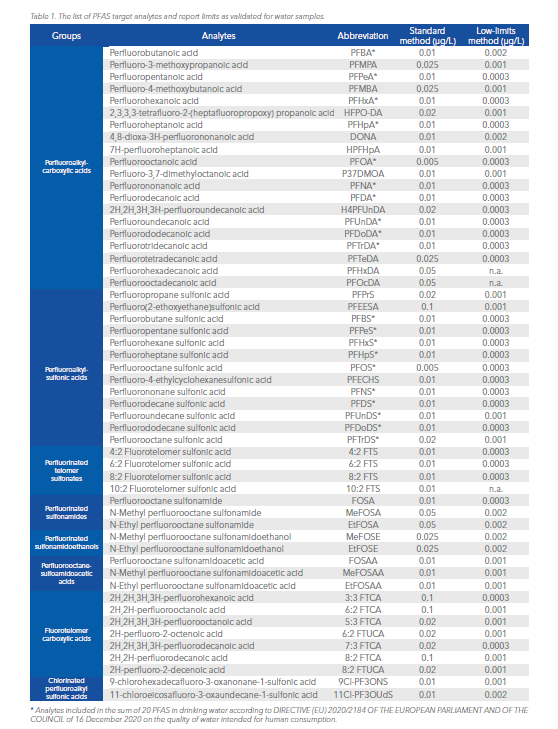PFAS TESTING IN WATERS: THE SCOPE OF ANALYSES AND CURRENT STATE OF LEGISLATION
Published: May 2023
Download PDF
EnviroMail_01_Europe_The Scope of PFAS Analyses in Waters and Current State of Legislation
ALS laboratories have again expanded the list of accredited analyses for the determination of PFAS. Persistence and bioaccumulation. Two essential characteristics, and two main reasons for the analysis of PFAS (per/polyfluoroalkylated substances). PFAS are already well-known industrially produced synthetics whose steadily increasing amounts in the environment are leading to the progressive introduction of regulations and legislative limits worldwide. ALS laboratories provide accurate, fast, and reliable accredited analysis of a wide range of PFAS, the list of which, as well as the range of matrices tested, is growing.

PFAS as we know…
Forever chemicals. A name that, unfortunately, has already been adopted for this group of synthetic compounds that can be detected across the all environmental components. The unique chemical structure of PFAS (more than 5,000 of them are described today) gives the final industrial products unique properties such as the mostability, dielectric properties, or the ability to reduce the surface tension.
Thanks to this, PFAS are used in various branches of industry and became a part of a whole range of products, e.g. mechanical components, electronics, firefighting foams, and/or common products in our homes such as cosmetic products, packaging materials, textiles or pans. High levels of PFAS detected in various components of the environment, as well as their already known adverse effects on human health, lead to the increasing demand for establishment of global PFAS regulations. The best-known representatives of this group are perfluorooctanesulfonate (PFOS) and perfluorooctanoic acid (PFOA), which were among the substances included in the Stockholm Convention in 2009 and 2019, respectively. In the future, other substances from the PFAS group are proposed to become a part, e.g. perfluor hexanesulfonate (PFHxS). ECHA (European Chemical Agency) has published a proposal for a plan to significantly reduce PFAS in almost all sectors and in the future allows their use only in those fields where they cannot be replaced.
Legislation and regulations
Until recently, PFAS legislation limits in drinking water in most of EU member states were set only for PFOS and PFOA by DIRECTIVE (EU) 2020/2184 OF THE EUROPEAN PARLIAMENT AND OF THE COUNCIL of 16 December 2020 on the quality of water intended for human consumption, valid from 1 January, 2022. It provides for a transitional period by January 12, 2026 for Member States to take the necessary measures to ensure that the values of two indicators for PFAS, namely „PFAS total“ and „PFAS sum“ are met for waters intended for human consumption. A limit of 0.1 μg/L has been set for the sum of PFAS for the 20 compounds marked with (*) in Table 1. For the „PFAS total“ parameter (limit of 0.5 μg/L), technical instructions will be drawn up and subsequently the Member States will be able to decide whether to use the “PFAS total“ indicator, the "PFAS sum" indicator, or both.
References
- DIRECTIVE (EU) 2020/2184 OF THE EUROPEAN PARLIAMENT AND OF THE COUNCIL of 16 December 2020 on the quality of water intended for human consumption (HERE)
- EnviroMail / Europe, No.2/2023: SamplingRecommendations for PFAS to Maximize DataQuality

ALS laboratories have again expanded the list of accredited analyses for the determination of PFAS. Persistence and bioaccumulation. Two essential characteristics, and two main reasons for the analysis of PFAS (per/polyfluoroalkylated substances). PFAS are already well-known industrially produced synthetics whose steadily increasing amounts in the environment are leading to the progressive introduction of regulations and legislative limits worldwide. ALS laboratories provide accurate, fast, and reliable accredited analysis of a wide range of PFAS, the list of which, as well as the range of matrices tested, is growing.

